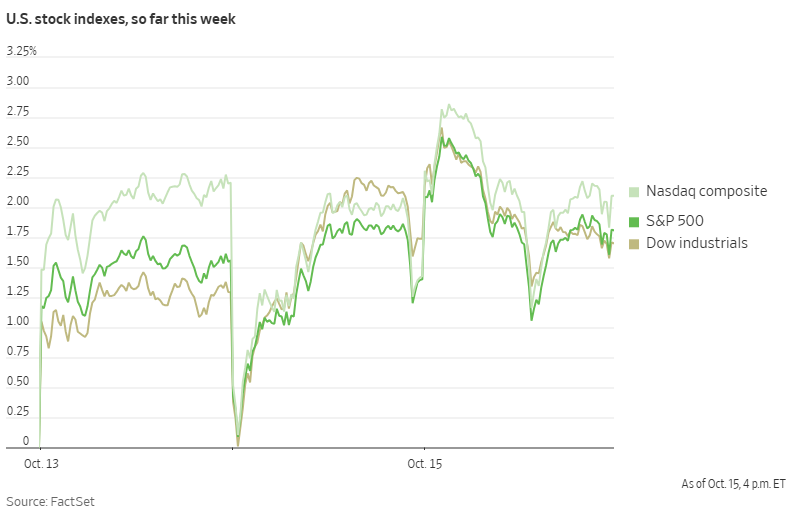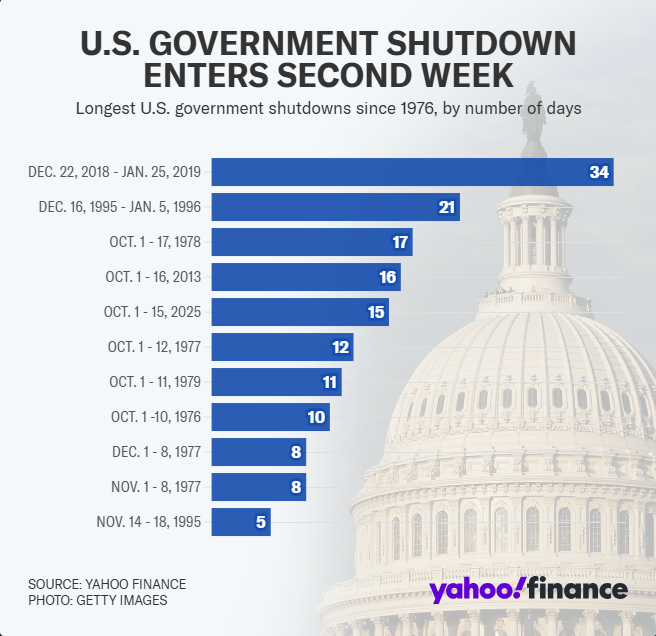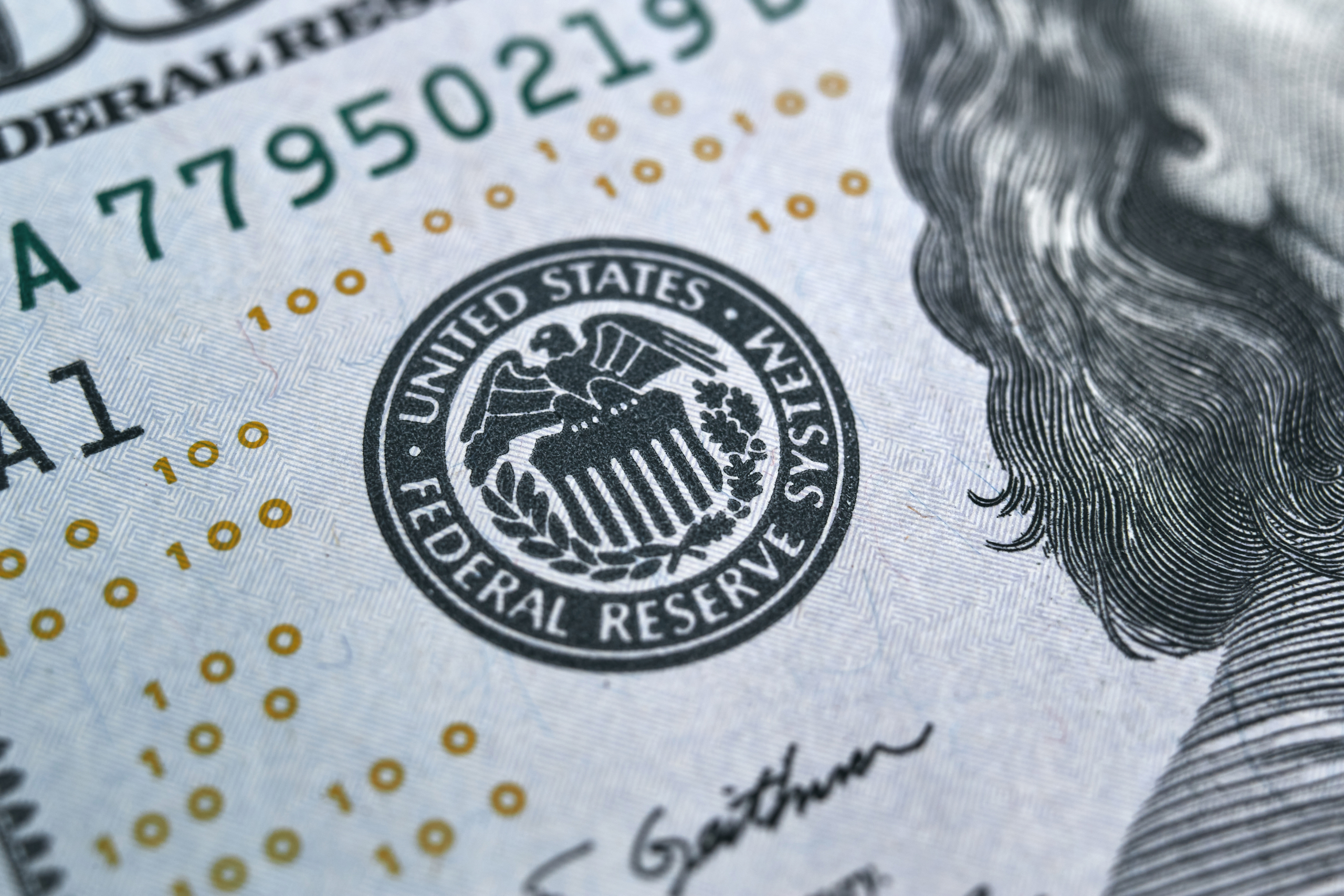Berita & analisis pasar
Tetap selangkah lebih maju di pasar dengan wawasan ahli, berita, dan analisis teknikal untuk memandu keputusan trading Anda.

S&P 500 and ASX Rally as Big Banks Drive Markets
Both the S&P 500 and ASX have rallied on the back of stronger-than-expected major bank earnings reports on both sides of the Pacific.
In the US, Bank of America reported a 31% year-over-year increase in earnings per share at $1.06, exceeding Wall Street's estimate of $0.95. Meanwhile, Morgan Stanley delivered a record-breaking quarter with EPS of $2.80, a nearly 49% increase from the same period last year.

On the Australian front, the benchmark ASX 200 leapt 1.03% to 8990.99, with all four major Australian banks playing a major role. CBA closed 1.45% higher, Westpac 1.98%, NAB 1.87%, and ANZ 0.53%.
These strong bank results indicate broader economic strength, despite recent concerns about US-China trade tensions. US Treasury Secretary Scott Bessent emphasised that Washington did not want to escalate trade conflict with China and noted that President Trump is ready to meet Chinese President Xi Jinping in South Korea later this month.
With the third-quarter earnings season just getting underway, these early positive results from financial institutions could prove as the start of continued market strength through to the end of the year.
U.S. Government Shutdown Likely to Last Into November
Washington remains gridlocked as the U.S. enters its 16th day of shutdown. With no signs of compromise on the horizon, it appears increasingly likely the shutdown will extend into November and could even compromise the Thanksgiving holiday season.
Treasury Secretary Scott Bessent has warned "we are starting to cut into muscle here" and estimated "the shutdown may start costing the US economy up to $15 billion a day."
The core issue driving the shutdown is healthcare policy, specifically the expiring Affordable Care Act subsidies. Democrats are demanding these subsidies be extended, while Republicans argue this issue can be addressed separately from government funding.
The Trump administration has taken steps to blunt some of the shutdown's immediate impact, including reallocating funds to pay active-duty soldiers this week and infusing $300 million into food aid programs.
However, House Speaker Mike Johnson has emphasised these are merely "temporary fixes" that likely cannot be repeated at the end of October when the next round of military paychecks is scheduled.

By the end of this week, this shutdown will become the third-longest in U.S. history. If it continues into November 4th, it will surpass the 34-day shutdown of 2018-2019 to become the longest government shutdown ever recorded.
This prolonged shutdown adds another layer of volatility to markets. While previous shutdowns have typically had limited long-term market impacts, the unprecedented length and timing of this closure, combined with its expanding economic toll, warrant closer attention as we move toward November.
Trump Announces Modi Has Agreed to Stop Buying Russian Oil
Yesterday, Trump announced that Indian Prime Minister Narendra Modi has agreed to stop purchasing Russian oil. He stated that Modi assured him India would halt Russian oil imports "within a short period of time," describing it as "a big step" in efforts to isolate Moscow economically.
The announcement comes after months of trade tensions between the US and India. In August, Trump imposed 50% tariffs on Indian exports to the US, doubling previous rates and specifically citing India's Russian oil purchases as a driving factor.

India has been one of Russia's top oil customers alongside China in recent years. Both countries have taken advantage of discounted Russian oil prices since the start of the Ukraine invasion.
Analysis suggests India saved between $2.5 billion to $12.6 billion since 2022 by purchasing discounted Russian crude compared to other sources, helping support its growing economy of 1.4 billion people.
Trump suggested that India's move would help accelerate the end of the Ukraine war, stating: "If India doesn't buy oil, it makes it much easier." He also mentioned his intention to convince China to follow suit: "Now I've got to get China to do the same thing."
The Indian embassy in Washington has not yet confirmed Modi's commitment. Markets will be closely watching for official statements from India and monitoring oil trading patterns in the coming weeks to assess the potential impact on global energy flows and prices.
Chart of the Day - Gold futures CFD (XAUUSD)


For years we have been told that ‘value’ will have its day again. The reasoning is vast, deep value in value versus overpriced growth, pricing in risk is stretched, the ‘free money decade is over, and growth will be left holding the bag. You can take your pick as to what reasoning you use regarding this market conundrum, but the conclusion is this.
Growth is still monstering value. Thus let’s review the ASX 200, one of the clearest ‘value’ plays out there with its high exposure to defensive, value and cycle sectors versus some of it global peers. May saw the ASX 200 index rising by just +0.9% compare this to the +4.8% rebound observed in US equities or European equities that saw gains of between 2% and 6%.
Yes, parts of Europe are more ‘value’ than the US but in the main the ASX’s underperformance is something of a continuing trend of the past decade. The drivers of the global rebound were largely influenced by weaker economic data and comments from the Federal Reserve, which indicated a lower probability of imminent interest rate hikes. Countering that for Asia (and thus Australia) was a weaker than expected rebound in China, an easing in iron ore and overall concern that Asian growth is starting to drag.
Thing is – if you look at the sectors inside the ASX the growth versus value trade is playing out here: Sector Performance Technology (+4.5%): The biggest “growth” area - Technology led the ASX gains, buoyed by the big lead player in the likes of Xero (XRO, +10.6%) and Technology One (TNE, +9.7%) which both release strong earnings numbers in the month. These results underscored the sector's potential for substantial earnings growth despite the pressure from high bond yields, which flies in the face to the macro view that growth is facing a funding issue. Furthermore - The majority of the sector's rise was attributed to actual earnings improvements rather than just price-to-earnings (PE) expansion, which has been seen in places like Staples and Discretionary.
Banks (+3.6%): Each year May is sometime renamed - Bank earning month. The lead up expectations to the release from NAB, ANZ, WBC and Macquarie were mixed. The fears from the market included: the ‘mortgage cliff’, lower new loans and margin risk.
The results even surprised the CEOs with all suggesting they were pleasantly surprise by the ‘resilience’ of banking customers this saw a positive earnings season characterised by lower-than-expected impairments and margins that were not a low as expected. Communications (-2.8%): This sector was the laggard, with a notable -4.6% decline in telecom stocks. The negative performance was driven by Telstra (TLS, -5.4%), which announced a shift away from CPI-linked post-paid mobile pricing, causing market concerns.
If there was ever a stock that highlights ‘value’ that isn’t value TLS, is it. Low project pipeline and the prospect of flat earnings and a high payout ratio makes TLS that stock that is siting no-mans-land. Key Stock Performances Aristocrat Leisure (ALL, +13.5%): ALL was the standout performer in the ASX 50, following a strong first-half 2024 earnings beat and the announcement of a strategic review of its subsidiaries BigFish and Plarium.
Negative Surprises: Several stocks experienced significant declines due to disappointing earnings. These included James Hardie Industries (JHX, -13.7%) and Sonic Healthcare (SHL, -9.1%) among large caps, and Bapcor (BAP, -26.5%), Eagers Automotive (APE, -19.9%), and Fletcher Building (FBU, -18.2%) among smaller caps. All had structural reasons for there declines – but in the main these are players are exposed to cyclical issues and either can’t grow or are areas of economic slowdown.
Getting back to market momentum Looking at the market action and momentum in May there was something of note. Buying ‘speed’ – that being a measure of positive equity market sentiment, increased to 1.21 in May from 0.68 in April, indicating heightened investor enthusiasm despite the underperformance versus global peers. Historically, when buying speed exceeds 1, ASX forward returns tend to fall below average over the following year, suggesting a potential risk of a market correction.
Additionally, June is traditionally a weaker month for ASX equity returns, often impacted by tax loss selling and other end of financial year movements. Other influences Despite a higher-than-expected CPI print in May, rate expectation interestingly enough moved into a slight dovish position (if only just). ASX Cash Futures are currently indicating a 5% chance of a 25-basis point rate cut in June.
This might not seem relevant but it i a shift from a previously expected 3% chance of a rate hike. This fluctuating expectation reflects ongoing uncertainty in the economic outlook is creating a risk level in bond and fixed income markets that hasn’t been seen for months. The conclusion from this is the RBA’s job is far from over and that market is clearly confused about when a rate movement in either direction will occur.
This makes the ASX momentum that much hard to gauge as it is now competing with markets that are facing definite cuts in 2024. This can explain Europe’s outperformance as during the month of May the ECB has all but declared that it will cut rates in the coming meetings even as soon as the month. While the Riksbank cut rates for the first time in over half a decade seeing the Swedish bank being the second central bank in the G10 to cut rates in 2024 behind the SNB.
The take outs? While May saw a positive, albeit modest, performance for ASX equities, driven primarily by strong earnings in the technology sector, there are several indicators suggesting caution in the coming period. The significant increase in buying euphoria points to a possible weaker June performance highlight the potential for a near-term market correction.
Then there is the cash allocation between global markets. With the slowing Chinese economy being a persistent issue, the “higher for longer” position from the RBA and then Europe and the US facing recharged economic conditions funds are likely to shift once again to the areas of growth seeing the ASX once again underperforming. Thus investors should be mindful of these risks, particularly with upcoming earnings reports and central bank decisions on the horizon.


We have been scratching our heads as to what exactly drove some of the strong price action in pairs, equities and bonds off the back of a further hawkish turn from the Fed at its June meeting. So, what exactly has promoted the moves on markets and what else should we as traders acknowledge from the Fed meeting First Powell has pointed to a positive change in the latest CPI inflation report. The 3.3% year on year rate was better than expected and is finally moving back in the right direction after the first quarter saw raises rather than declines.
Chair Powell's comments at the press conference leaned more dovish, emphasising "broad" labour market data indicating that the labour market had returned to a pre-pandemic balance. He noted that further loosening might be seen as unnecessary and expressed no concern about an overly strong labour market despite recent robust payroll readings. Here is a decent chunk of his message: "If the economy remains solid and inflation persists we're prepared to maintain the target range for the federal funds rate as long as appropriate.
If the labour market were to weaken unexpectedly or if inflation were to fall more quickly than anticipated, we're prepared to respond. Policy is well positioned to deal with the risks and uncertainties that we face in pursuing both sides of our dual mandate. We'll continue to make our decisions meeting by meeting based on the totality of the data and its implications for the economic outlook and the balance of risks," However, he cautioned that there are clearly big areas of concern namely, owner's equivalent rent (OER) did not decelerate (again) and with an 5.3% annual rate in the latest release it is eons away from where the board needs it to be.
If OER continues at this pace, it will be challenging for the FOMC to bring inflation sustainably back to 2% or gain confidence that it is heading there. Chair Powell emphasised the need for consistent structural data reasoning to move – clear in this quote "One reading isn't enough. You don't want to be too motivated by any single data point." This is pretty clearly reflected in the latest Dot Plot, which is now signalling only cut in 2024 down from 3 at the March meeting.
We have highlighted that in the orange and blue lines that shows the marked difference between the two. The critical question now is whether there is sufficient data for the September FOMC meeting to justify starting the rate cut cycle in 2024. You only have to look at the record highs in US indices and the collapse in US yields to think September is near enough to a certainty.
Is this the view of the FOMC? The Committee will receive three more employment reports and three more CPI reports before the September meeting. Given their preference for communicating actions ahead of time, the timing of the first-rate cut will be significant and well flagged.
If you look back at the dot plots there is something clearly communicated there. Currently, 11 out of 19 board members expect to hold rates until December or even into 2025. Thus, as the majority see a holding pattern you could even argue that waiting for the fourth CPI and employment report plus 2 quarterly GDP reports if the board was to wait until November would be a more likely outcome.
Of the eight participants who favour two rate cuts this year, it's estimated that this includes three to five regional Fed Presidents that are non-voting members and have minimal influence on policy. All things being equal and judging by his public comments and history Powell is likely among those favouring a single cut, he will need to build consensus among the board members that are voting members and that appears easier said than done considering several of these players are hawks and will sit in the group that is holding rates out to 2025. To realistically consider a rate cut in September, a significant shift in data is needed in the next two months.
This is why we are asking the market – is less more? Less cuts, less clarity on inflation but clear drive into bullish positions? We know not to ‘fight momentum and the trend’.
But it is also prudent to stop and ask if a swing back is likely. Unless there is a substantial weakening in growth and employment the prospects of a September cut look poor. And, given the FOMC's cautious approach over the past 18 months and substantial lead time required for such decisions.
The consensus forecast in the labour market, sees moderation not a rapid decline, which does not support a rate cut in September. Thus mind the blow back as this concept builds momentum and shoves markets back the other way. So, what exactly has moved the dial in markets to be so positive?
We think it’s the comments he made during his press conference that somewhat poured cold water on what have traditionally been seen as bedrock data. First - Powell downplayed the importance of the Fed's summary of economic projections (SEP) and the "dots," describing them as mere possibilities. This feels like the good old days of the Yellen era where she too would remind everyone that forecasts are just that forecasts not actuals.
Will point to something that might have been missed – he also stated that officials could revise forecasts and dots after the release of CPI data, though " most don’t." Here are some of the key revisions in the SEP - an expected increase in core PCE inflation from 2.6% to 2.8%, reflecting higher-than-expected inflation in Q1 remembering that this is the measure the Fed needs to at or around 2%. The unemployment rate and GDP growth were left unchanged at 4.0% and 2.1%, respectively. Second – The dot plot projections showed an upward revision of 25 basis points for 2025.
Really this is just a push back of the rate expectation for this year. But and it is a large and consistent but – The dot plots suggest once the cuts begin the path of quarterly rate cuts once they begin cuts will be rather consistent. This view has not changed since reaching the peak of the hike cycle.
So if this is indeed the case – market positioning is banking on this time next year being the ‘middle’ of a significant rate cutting cycle.


The consensus for the monthly Consumer Price Index (CPI) is for a rise to 3.8% annually in May, the range being 3.6% to 4.0%. This would be the fourth consecutive rise in yearly inflation and would show that not only is inflation ‘sticky’ it could be considered ‘entrenched’ Monthly CPI indicator YoY% This headline will cause large initial reactions from both the FX and bond markets. Considering the hawkishness in which the governor has spoken about getting inflation back to target inside its 18-month timeframe the market will see this as another confirmation that the August meeting is more than just live but a very probable moving event.
You only have to look here at the 30-day interbank market to see long calls are being made although not at a large scale (yet). Since breaking out in late May on signs inflation has become sticky and rate rises rather than cuts are the more likely RBA response in the near term. The pair has become range bound between $0.658 and $0.672.
AUD/USD Which brings us as to why May might be the last CPI rise before it begins a long slow decline into the target range. Notable Influences on May Inflation Fuel: Prices declined significantly in May, more than offsetting April’s increase. However, they rose again during June to over 200c/l.
Food: Inflation eased modestly over the year, with restaurant meals and takeaway food prices moderating on weak demand. Rents: Returned to the average 0.7% monthly after the temporary rent assistance indexation. Clothing & Footwear: April’s unexpected price increase is expected to reverse in May amid ongoing weak retail conditions and the onset of end-of-financial-year sales.
Electricity: Victoria’s rebates expire, with significant price drops anticipated from July due to new federal and state rebates. Firstly, we need to point out that May 2023 has several factors come into play that will create an artificial upside. For example, the expiration of electricity rebates in Melbourne there are several other similar government interventions that also impact in the same way.
Then there is the persistent high inflation in sectors like insurance, which will obscure the declining progress being made in market services inflation. Now we need to highlight that the consensus view is the downward trend will resume in June, consensus forecasting (remembering that there is a lot of data that can shift this ahead of the July 31 release) for Q2 2024 headline CPI sits a 3.6% annually the RBA’s Statement of Monetary Policy (SoMP) is at 3.8%. Prices were unusually weak in May last year, due to significant drops in domestic travel (-15.5% monthly) and fuel (-6.7% monthly), which together account for approximately 7% of the CPI basket.
Large declines of this nature are not expected to repeat this year. Additionally, rebates and changes to electricity prices as energy rebates in Victoria expire, contrasting with the quarterly payments in other states this explains why consensus has CPI falling post May. On electricity pricing expectations are for prices to fall by around 20% in July as new rebates are introduced.
Consensus also anticipates a significant drop in clothing and footwear prices, reversing the April increase. The growth in average monthly spending on clothing and footwear shown in the latest credit card data was the lowest for May since the pandemic. Then you have the seasonal decline in holiday travel and accommodation prices post-school holidays.
Put this all together and it should make plain that Wednesday’s CPI monthly read could be a trap for traders. Why? Yes continued rise in the monthly CPI indicator will be unwelcome news for the Reserve Bank of Australia (RBA).
However, the RBA has emphasised that the quarterly CPI release remains the benchmark inflation figure in Australia. With that being the case – watch for snap back in any bullish moves in the currency. Because although its challenging to predict the trimmed mean CPI based on monthly CPI indicators.
Expectations are that core CPI (which can vary significantly from the quarterly trimmed) comes between 0.8% and 0.9% quarterly. This will be refined post the May CPI but all the same it is likely to be lower quarter on quarter. If we use the RBA’s latest forecasts the headline rate 1.0% on a quarterly basis (3.8% annually).
Trimmed mean CPI is sitting at 0.8% on a quarterly basis (3.8% annually). These are the keys to trading CPI going forward as the underlying detail will be key. First break out market services.
Watch meals out and takeaway, hairdressing services, insurance, sporting and cultural services, and sports participation. Then we need to see modest consumer spending growth for discretionary items and an easing in wages growth this would result in further disinflation for market services, which is paramount to getting inflation back into the target band. CPI Breakdown for May Category April Weight Annual % Change Monthly % Change Expected Annual % Change Food and non-alcoholic beverages 17% 3.8 0.4 3.1 Alcohol and tobacco 7% 6.5 0.0 6.4 Clothing and footwear 3% 2.4 -2.2 2.1 Housing 22% 4.9 0.5 5.3 Furnishings, household equipment & services 8% -0.8 0.3 -0.8 Health 6% 6.1 0.0 6.1 Transport 11% 4.2 -0.7 5.6 Communications 2% 2.0 0.5 1.7 Recreation & culture 13% -1.3 -3.3 -0.1 Education 4% 5.2 0.0 5.2 Insurance & financial services 5% 8.2 0.6 7.6 CPI Indicator - 3.6 -0.3 3.7


FX and indices traders are now on notice – the race to restart economies is upon us. We have to-date seen Riksbank and SNB move policy but with the Bank of Canada (BoC) now entering the rate cut movement – the race is now well and truly on and the interest rate differentials that come into play with currencies will ramp up. Potential for Further Cuts In a move that surprised some analysts but aligned with market expectations, the Bank of Canada (BoC) has reduced its policy rate from 5.0% to 4.75%.
It’s the first time the BoC has cut rates since March 2020. It is a clear shift in thinking and reflects a much more dovish stance than anticipated. It also sends a clear willingness to further lower rates if inflation continues to ease and confidence in reaching the 2% inflation target grows.
The impact on the CAD and Canadian bonds post the decision is stark. USD/CAD (source Refinitiv) However the post-reaction even more interesting. The spike and then sell off is a clear recognition from FX traders and fund managers that if the BoC is moving rates the Fed is not far off it either. (More on this below) A Dovish Turn So what has led to the dovish turn from the BoC and what can been extrapolated to over similar geographics from the BoC Decision?
Based on current domestic inflation data, headline Consumer Price Index (CPI) is expected to moderate, helped by factors such as easing mortgage costs. The primary reason for the rate cut was the slowing of core inflation and the reduction in broad-based inflation increases. We should point out that Europe, the UK and Canada are seeing this – Australia and the US not so much.
There is uncertainty about whether core inflation will continue to improve as favourably in the coming months – and the more hawkish BoC watcher were keen to point this out The Canadian Federation of Independent Business (CFIB) suggest that core inflation might stabilize around 2.5-3% which is above the levels most would predict for further cuts. However, history shows the BoC like most central banks never really goes ‘one and done’ it is normally coupled with two or three moves. Which again suggests CAD crosses against those economies that are not likely to see rate cuts in the coming months will benefit as the CAD falls.
South of the Board - US Economic Activity A weakening US labour market and economic activity are expected to spill over to Canada, potentially impacting Canadian economic growth. This development is currently not in the BoC’s base case, which expects stronger growth in Canada this year. BoC Governor Tiff Macklem's comment that “there is room for growth even as inflation continues to recede” suggests that officials expect a scenario of stronger growth with easing inflation in the coming months.
Any deviation from this expectation towards weaker growth would likely prompt more dovish policy actions. Recent data suggests Macklem and Co. might have to rethink this view Data Dependence and Future Rate Decisions Like all central bankers looking for their ‘get out of jail free card’ - BoC officials have consistently emphasised data dependence in their making decisions. Which is interesting as recent Canadian activity data, was showing strong job growth, yet this was somewhat downplayed in the decision – this could also feed into the reaction of the CAD in the hours post the decisions as the initial dovishness was evaluated with a hard lens.
Employment is described as growing at a slower pace than the working-age population, a trend that has persisted even pre-pandemic. If activity data continues to evolve as it has recently and core inflation picks up in May and June CPI data, the BoC may forego a rate cut in July. However, the base case scenario anticipates some slowing in activity and particularly weakening US data, which could result in updated growth forecasts in the July Monetary Policy Report (MPR) being less favourable than in April.
This alone could lead the BoC to cut rates again in July. Where does that leaves us? The BoC cut to 4.75% marks a shift towards more accommodative monetary policy amidst a complex economic landscape.
With inflation showing signs of moderation and potential headwinds from the US economy, the BoC remains vigilant and data dependent. Future rate decisions will hinge on the evolving economic conditions and inflation trends, with further cuts likely if the current trajectory of easing inflation and economic activity persists. CAD now very much sits in the dovish and weaker end of the G10 currencies.
That bias is unlikely to change again the likes of the AUD which is clearly sitting at the higher end of the G10 spectrum. So that’s Canada – what about Europe? All things being equal - the European Central Bank (ECB) is poised to start cutting interest rates for the first time in nearly five years tonight.
In a move well forecasted to the market it is expected to stimulate the eurozone economy that is now flirting with, or in some case already in recession. To put this decision into some context - the ECB had previously raised its benchmark deposit rate to a historic high of 4% to combat significant inflation caused by supply side issue out of COVID and the war in Ukraine. Consensus suggest that the scope of economic stimulus will depend almost purely on the extent of the total rate reductions rather than other programs the ECB has engaged in in the past.
For example something that might hamper the economic recovery through rate cuts in Europe is rapid wage growth leading to high inflation limiting the number of cuts expected. This is certainly impacting the thinking of traders, the EUR has a known cut cycle in front of it – yet its holding relatively well suggesting traders are not as dovish on rates as economist and the ECB is. Thus it’s not the announcement that traders and investors will focus on.
It’s the guidance from ECB president Christine Lagarde regarding future monetary policy. The stated aims currently in lowering rates is to invigorate housing markets, business investment, and consumer spending, which have been restrained by high borrowing costs. Which have significantly impacted economic activity, but with inflation pressures now easing slightly, the bank sees an opportunity to support growth.
There is also a growing amount of evidence that is suggesting the economic behaviour of Europeans is already changing from the expected cuts. The public awareness of the cuts is boosting sentiment among households and businesses and may also mean rates don’t have to move as much to stimulate. The eurozone economy showed signs of recovery in early 2023, with a GDP increase of 0.3% in the first quarter, ending a period of stagnation.
This growth was largely due to subsiding energy and food price shocks coupled with a global trade recovery. But it was also aided by the anticipated rate cuts lowering mortgage and corporate loan costs. In Germany, house prices, which have dropped by 10% following the ECB’s rate increases, have started to stabilize as mortgage rates have fallen from nearly 4% to below 3.2%.
This has led to a noticeable increase in mortgage financing demand, spurring a housing market upturn. Similarly, in the Netherlands, rising wages, housing shortages, and lower mortgage costs are expected to push house prices to new highs. And as mentioned - the eurozone's robust labour market is contributing to persistent inflation, with wage growth hitting a record pace and unemployment reaching a low of 6.4% in April.
This strength may prompt the ECB to slightly adjust its inflation and GDP growth forecasts upward – which again supports the markets view that the EUR may perform better than against a CAD for example. Thus the ECB is likely to proceed cautiously with rate cuts. Influential ECB officials suggest a gradual pace, with only a few cuts anticipated this year to maintain flexibility and ensure inflation continues to decline towards the 2% target.
The ECB's approach contrasts with previous rate cuts cycles in the zone, which were typically reactions to economic crises. This time, the cuts are being made in a context of improving economic conditions, suggesting a measured approach to avoid overheating the economy. Overall, while the initial rate cut is seen as a certainty, the future path of ECB policy will depend on ongoing economic developments and inflation trends, with the bank aiming to balance stimulating growth and controlling inflation.
A tough fundamental backdrop for EUR traders.


Never has the oil been trickier than it is right now. The influences on the price are complex, varied and time dependent. It’s even trickier when you look at it from the trade of commodities versus equities.
Here are the key things that are catching our attention with oil trading in spot, forwards and equities. Spot vs. Anticipatory Market While WTI and Brent prices are influenced by current ('spot') market conditions, they are not solely determined by them.
There is a level of anticipation of supply, and these are priced through mechanisms like storage and forward curves. This allows the market to shift supply into the future or pull it forward as required. Right now however, demand and supply are so out of traditional cycles, pull forwarded supply is being re-stocked and future supply cut to offset the current scenario.
This might explain why forward curves are inverting – these curves are crucial in regulating the anticipatory nature of oil prices. Forward curves represent the market's expectation of future prices and influence current trading behaviours. Clearly even with supply cuts.
The market expects price to fall further if the forward curves are to be believed. Investment Time Horizons Do not forget the fundamental market pricing in equities. Share prices reflect prospective multi-year earnings growth.
The future earnings of a company can drive up its stock price today because equities discount future earnings to the present. This can explain why oil espoused equities are outperforming spot prices. The spot market does not look as far ahead.
Recent Market Reaction: The sharp negative reaction to OPEC's recent production decision seems irrational in light of the projected tightening of the oil market. The analysis indicates that crude oil inventory draws could reach up to 2 million barrels per day (mb/d) during the third quarter (3Q), suggesting a tighter market. Despite this, the current market sentiment reflects a different view, possibly driven by shorter-term concerns or overreactions to OPEC's decisions.
Seasonal Considerations: Between May and August, global demand for refined products typically rises by approximately 3.2 million barrels per day (mb/d). A similar increase is expected for 2024, driven by seasonal factors. Fundamentals assume oil prices reflect the expected supply/demand balance about 2-3 months into the future.
With that in mind, and looking at demand history Brent might have found a floor in the high-$70s per barrel range and are likely to recover in the coming months. The front-month Brent future for August delivery, are above July and shows that traders are already factoring in the peak northern summer demand. But, and it’s a big But, unlike last year's northern summer tightness which significantly boosted Brent prices higher-than-expected, inventories have tempered expectations.
Thus, calls for Brent to reach $90 per barrel now appear overly ambitious. With inventories higher than previously anticipated, the short-term forecast has been adjusted downward by $1.5 to $4 per barrel for the coming quarter to $$80-$86 a barrel. Post the northern summer period futures are falling fast as those seasonal demands, turning tailwinds into headwinds.
Previous forecasts already showed a declining price trend post the summer quarter. Considering the anticipated surplus in 2025, Brent prices may struggle to maintain the $80 per barrel mark next year. And this will start to impact not just spot and futures but also equities.
The OPEC dynamic OPEC has extended its production cuts, including additional voluntary cuts, through the end of 3Q. Assuming compliance (watching Iran, Iraq and Venezuela here) OPEC production is expected to remain stable during this period. OPEC is expected to remain proactive in managing production levels.
There is a realistic chance that OPEC will limit the unwinding of production cuts well into 2025, preventing a significant price drop and regulate price extraction. Saudi Arabia is known to want a floor in the price at $85 a barrel. Then there is non-OPEC – a temporary slowdown in non-OPEC supply growth is anticipated due to the timing of new projects.
This is interesting as historically non-OPEC loves to step in and soak up cuts from OPEC but appear to be caught slightly on the hop this time around. Limited production growth is expected through September but will increase into the back half of the year and into 2025 as OPEC holds the line. This push pull between the two groups is likely to see a supply surplus and modelling suggests this will make maintaining Brent prices above $80 per barrel challenging.
A full $5 below the comfort level of OPEC. It suggests that OPEC could step in again and cut supply to drive the price higher. However this is when we would expect smaller nations in the OPEC group to splinter as the impact on them is greater than larger players.
Implications for Market Participants Short-term Traders: Should focus on the anticipated supply-demand balance in the next 2-3 months. The expected tightening in 3Q suggests potential price support or increases in the short term. Be ready for price shifts in September and rapid changes in curve the closer we get to August expiry.
Long-term Investors: Need to consider the broader outlook, including potential seasonal shifts, OPEC's future production decisions, and long-term production growth from non-OPEC countries. Look also to forward earnings estimates, possible consolidations and firms that start to pivot from pure oil exposure. This is gaining momentum at the likes of BP, Shell, Woodside and the like.
The long-term dynamic of oil is really that of structural decline as the world moves to renewables and EVs. This is years away no doubt, but the changes and future earnings impacts are starting now – so be alert. Overall, while immediate market reactions can sometimes seem disconnected from longer-term fundamentals, a nuanced understanding of both short-term and long-term factors is crucial for effective oil market analysis and trade decision-making.
The recent analysis reflects adjustments based on current market conditions and forward projections and we hope this provides a baseline for those of you looking at oil and the tricky trading conditions that are present.


Last week I highlighted Governor Chris Waller’s speech – however the more I look into his talk the more it needs greater emphasis as it contained both hawkish and dovish elements. The Hawk Waller indicated that he would need at least three more months of "good" inflation data before considering a rate cut. He was suggesting this might happen late this year or early next year.
The Dove However, while he supports delaying the first cut, he emphasised that he does not expect to hike rates further. More importantly he highlighted that once the initial cut is made it should be followed by a series of cuts at no slower than a quarterly pace. That is a pretty aggressive stance it gives traders a clear understanding that once the Fed starts lower yields will be coupled with lower USD values – it’s just a question of when does it start?
The catch will be EUR, GBP, SEK etc are also facing dovish central bankers so these pair will have some push on them. Just remember ‘don’t fight the Fed’. Toeing the line Waller also reiterated the now-standard Fed caveat about rate cuts: a significant weakening of the labour market would prompt Fed officials to cut rates earlier or more aggressively.
Reviewed the plethora of labour market indicators out of the US and it is pretty clear further softening is likely. Looking at the non-farm payrolls in April only 175k jobs where added, and the forward-looking May hiring surveys show further slowdowns. Risks are skewed to the downside, and a sub-100k or even negative reading in the next few months wouldn't be surprising.
Hiring rates according to JOLTS and hiring intentions according to NFIB have dropped rapidly, and the employment subcomponents of services PMI and ISM are below 50 in most states. Now, the unemployment rate, currently sits at 3.9%, the Fed’s year-end forecast is 4.0% that could be reached this month – so next week’s NFP is going to huge for US indices and USD bulls that are staking everything on a ‘soft-landing’ and rate cuts in 2024. Looking to the next major indicator - Retail sales, which have been weak in the first four months of 2024.
It’s clear rate rises are biting, and consumers are depleting their excess savings acquired during the COVID years. Retail discounts are starting to ramp up have just to maintain sales volumes. This leads us to real GDP growth because it has a mixed set of data.
Real GDP slowed to an annualised 1.6%, but inside that figure was final private domestic demand. Which was buoyed strong consumer spending and contributions from business and residential fixed investment seeing it come in at 3.1%. A contradiction to the retail sales numbers.
However, investment looks to be weakening, with durables orders and shipments remaining soft in the second quarter of the year. Couple is with high mortgage rates and house prices have also resulted in softer housing data. This suggests that private demand in Q2 will eventually fall back in line with other components of the GDP reading.
All this again backs the consensus trade views that US indices are riding the soft-landing wave and are in the main driving USD inflow. Great example is AUD/USD – the AUD has been a huge performer in 2024 as the RBA looks to be pushing out expectations of rate cuts, couple this with booming commodity markets and a China looking to bounce out of malaise, yet the pair is stuck in a range of $0.64-$0.67. Against EUR, GBP JPY the AUD is going one way – not in the pair though and shows how attractive the US is for investment and flow.
Let me come back to Waller’s ‘good’ quote on inflation. In his remarks he suggested this week’s PCE expected to come in around 0.24-0.26% MoM April a "C+" grade. That would suggest sub-0.22% is "good” and would need several months of that kind of figure to move.
This is a figure traders need to have in the back of their minds each month especially on the lead up to and just after the data hits the wires. One final part of the PCE - Fed minutes indicate that a further slowdown in shelter prices will be crucial for Fed officials to be confident that inflation is easing. This is yet to materialise in the data.
Considering how big a component housing is it needs to slow in this week’s reading or rate cut expectations will drift out even further. Speaking of the PCE what is expected? The Trade week Monday saw the US observe the Memorial Day holiday and trade leading into it was limited.
Al three major indices finished last Friday in the green with is a positive sign as holding long positions over a long weekend is rare. In short – indices will be a bit directionless until Wednesday as only then will global markets get their first trading day of the US week. Thus, we need to turn our attention to end of the week and position for the most important release of May PCE inflation on Friday.
This is a core metric of the Fed and if there is any chance of several rate cuts in 2024 this piece of the puzzle must show structural signs of decline. Based on CPI and PPI elements, the consensus estimates are for core PCE to rise by 0.24% MoM, rounding to 0.2% for the first time since December. Shelter inflation should slow gradually, and core services ex-shelter inflation should also slow relative to March.
The consensus range for core PCE is 0.20-0.26% MoM, we will await if this boosts Fed officials' confidence that inflation is moving towards 2%. The biggest take out of the consensus data is all expect April to show a slowdown in spending. Weaker goods spending which correlated from the weak retail sales last week should override a modest 0.4% MoM increase in services spending.
Overall real spending should remain flat. This will create debate in the market as indices bears point to the recent increase in Services PMI, as a sign of accelerating services activity and thus inflation is a long way off ‘returning to sustained level of inflation’ The second release of Q1 GDP will be out on Thursday, providing more comprehensive data on components like net exports, investment, and consumption. With March retail sales revised lower, there is a risk that consumption growth could also be revised down.
Case Shiller index due Thursday is expected to increase by another solid 0.63% MoM in March but anticipate softer home price increases in the coming months due to signs of weakening housing demand and improving supply of existing homes. Final part of the puzzle for trader is always Fed speak and there is a big one this week with NY Fed President Williams on Thursday. Recently, he indicated that he does not expect to gain "greater confidence" on inflation in the near term – and he is a voting member of the Board.
Turning to home: Oz data to watch Inflation April's CPI data is due Wednesday. Consensus is headline CPI to slow to 3.4% YoY from 3.5% in March (range is 3.2%-3.5%), following three months of flat or rising prints. As this is the first print of the second quarter, the sample will likely skew towards goods prices, resulting in softer monthly growth, consistent with the prior two quarters.
Either way a further softening in the monthly data will elevate fears the RBA’s narrow path is evaporating. Retail sales came out on Tuesday at 0.1% MoM a 0.5% jump on the March read. However, this blurs the biggest take out the annual growth is at historically low levels outside of the COVID period (1.2% YoY).
Consumers are finally slowing their spending habits. Australia 200 The A200 ended a five-week winning streak, on Friday down 1.1% for the trading week. For the month A200 is up 1.36%, any good news that can be taken from the CPI data on Wednesday should see the index lock in a positive May over all.

